If you have ever been to Japan, then you’ve become inspired by its wisdom. Japanese people rarely tell about it. But their life turns around the wabi-sabi philosophy. So, what is wabi-sabi?
Wabi-sabi is a Japanese system of views with 3 main principles. They are: 1) nothing is perfect, 2) everything is passing by, 3) nothing is over. The main idea of wabi-sabi is the ability to notice the beauty in imperfections. This belief system is everywhere. It is in the everyday life of a person, who follows it. It is in the organization of the super cozy tea ceremony, and in adding special home décor elements to your space.
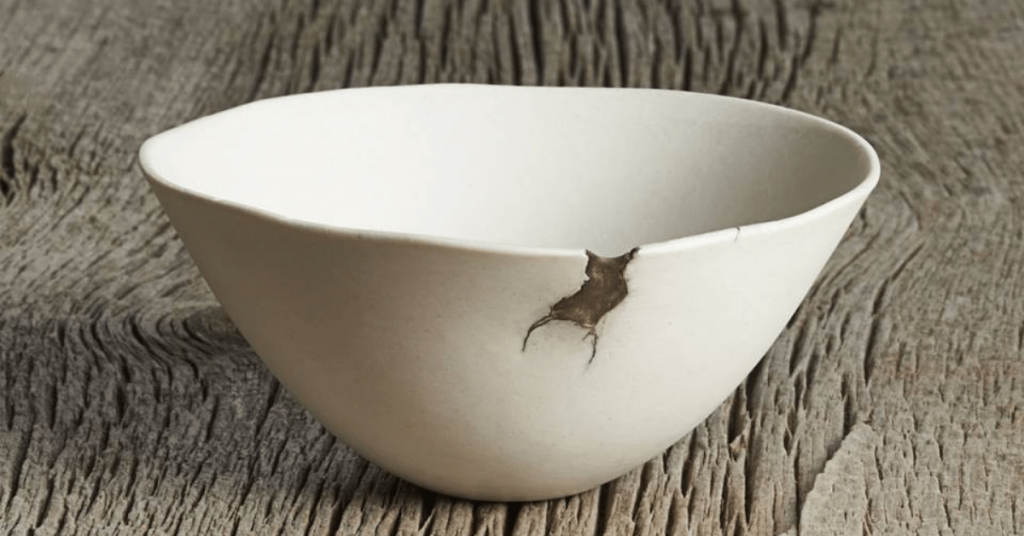
So, today I am going to speak on wabi-sabi in all possible aspects of this system. Let’s start!
What is Wabi-Sabi (Wabi-Sabi Meaning)
The main thing, I wanted to know about wabi-sabi is the meaning of this term and its translation into English. I looked into many dictionaries and even asked Japanese people, but nothing could help.
As one of my Japanese friends told me, “it’s hard to define wabi-sabi like it is difficult to define “love” or “friendship”. You can just feel it. How could you define, that this house is cozier than that one? It’s like your heart says to you.
In a few words, wabi-sabi is the conception. It tells us that beautiful things are not always perfect. I know that American and European people put lots of effort to create perfection. They build ideal bodies in gyms. They do plastic surgeries. And they buy the most expensive accessories for their home interiors. But Japanese people find beauty in wrinkles, dents, and cracks.
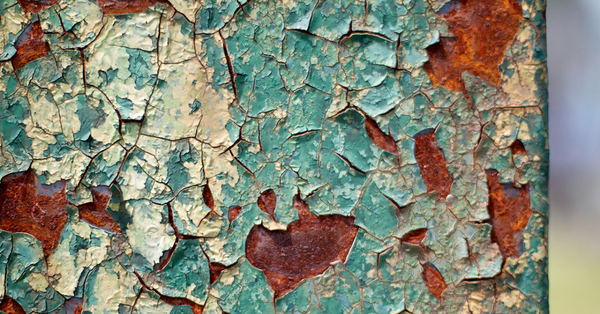
As you know, my blog is about home décor and carpet topics. So, my main aim is to tell you about wabi-sabi elements in home décor. But for you to know this topic deeper, I’d like to start with wabi-sabi philosophy in general. So, what does wabi-sabi mean?
What Does Wabi-Sabi Mean in Japanese?
Do you want me to translate the phrase “wadi-sabi” into English? I won’t be able to do it, as it is impossible to define it. The inhabitants of the Land of the Rising Sun express their delight with the phrase “wabi-sabi”.
To understand the meaning of this phrase, let’s divide it into two separates words – “wabi” and “sabi”
Wabi
This word means in English “muted sense of taste”. Since the Middle Ages, it meant in English “poverty” and “despair”. The verb, which derives from the noun “wabi” – “vabiru” – means “to worry” in English. The closest adjective – “wabisii” – means “unhappy, lonely, or poor”.
Is it possible to enjoy your life, when you are poor? I am sure, many modern Americans hate poverty. They work from morning till night to add a huge amount of dollars to their bank accounts at the end of the month. Nothing is great in old cups, rugs, and vases, is it?
But people, who lived in Japan in the 15th century, had another opinion. That was a hard time in Japanese history. Japan in the Middle Ages passed through lots of troubles and disasters. Such problems as famine, fires, and natural disasters happened often in Japan. People lived in extreme poverty and had no chance to succeed from their birth.
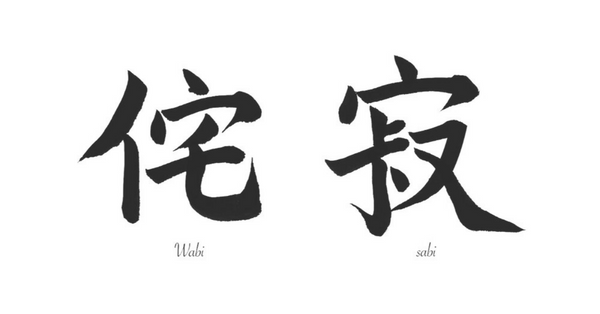
Japanese people could have spent their whole life, complaining about their hard fate. They wanted to get expensive beautiful dishware and furniture. But they chose another way. They started to notice the elegant and escaping beauty in old ideal things around them. Thus, the word “wabi” gained another sense. It changed the meaning from “poverty” to “escaping beauty”. Later “wabi” changed its sense again, when the word “sabi” appeared by its side.
Sabi
You cannot translate the word “sabi” into English, too. That notion has a connection with time. It goes any minute and gradually changes us and the things around us. Americans and Europeans put lots of effort to hide or correct the changes that time brings to them. They got rid of the wrinkles, the extra fat on their bodies, etc. Japanese value those changes. They see the special beauty in them. As they remind us of all the great events, which happened on their life path.
The exact meaning of the word “sabi” in English is “patina”. It is the sheen on some surfaces, which appears with aging. The closest adjective to the noun “sabi” – “sabisii”, means “lonely”.
Connected in one phrase, “wabi sabi” means the intention to see beauty in imperfections. Wabi-sabi celebrates antisymmetry, irregular shapes, dents, and cracks on things. This philosophy has its roots in Zen Buddhism. At first, its great ideas appeared in tea ceremonies, so popular in Japan. But let’s start from the very beginning.
Wabi-Sabi History
As I’ve already told you, my dear readers, we are fond of ideal symmetry and classical beauty. Wabi-sabi, on the opposite, is about seeing beauty in imperfect old things.
Can you find in your soul some respect for the things, which are aging, broken, or have some cracks? Then, you can feel confident in the wabi-sabi world.
1911: The Start of Wabi-Sabi
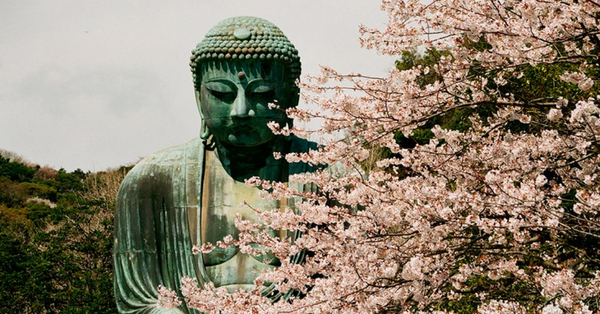
The start of this world was in 1911 in Kyushu, Japan. That year the monk, named Eisai, came from China to Japan and founded there the first Zen Buddhist temple. This new Japanese religion had a focus on meditation, nature, and imperfect things. Zen Buddhism served as a philosophical base for wabi-sabi.
XIV century: The Appearance of the Term “Wabi-sabi”
In the 14 century the words “wabi” and “sabi” formed one notion. It had more positive meaning than two words separately. You can read above in detail the meaning of “wabi-sabi”.
XV Century: Tea Ceremony in Wabi-Sabi Style
Then “wabi-sabi” evolved from a philosophical system of views to interior design ideas. At first, they used wabi-sabi ideas to organize a tea ceremony.
Everything began in 1488, when Murata Jukō, the Japanese monk, wrote a letter to Furuichi Chōin, his student.
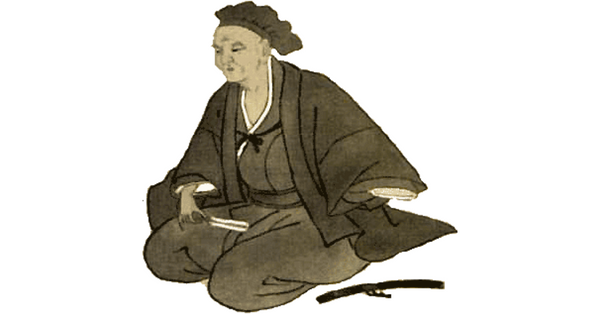
Now, we know this letter under the name “Kokoro no fumi” (in English “The Letter of the heart”). This letter was a document, in which Murata Jukō described in detail, how to organize the tea ceremony. He told about the field, where they should grow up tea leaves. Then he described tea utensils to use. Thus they created the unique calm atmosphere of the ceremony. As you can guess, Murata Jukō offered to organize the tea ceremony in Wabi-sabi style.
The tea ceremony appeared as a way for monks to stay fresh during long meditations. The hot strong tea added the monk’s extra strength and stamina.
Later tea ceremonies became more lavish. Rich shoguns brought expensive ceramic cups and dishes from China. They used utensils to drink hot strong tea on rich premises.
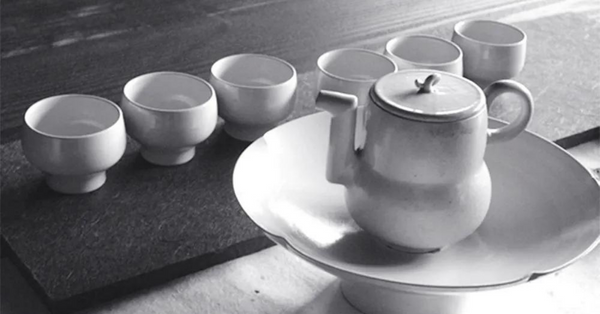
Murata Jukō in his letter advised refusing luxurious cups and kettles. Instead, he offered to focus on the taste of strong tea. Not to distract attention from the tea taste, Murata offered to drink it on the small balcony. While drinking, participants were watching the moon in the clouds. It was good to see half of the moon to enjoy its imperfection.
XVI Century: The Appearance of Wabi-cha Traditions
The tea master Sen no Rikyū made the next step for wabi-sabi ideas development.
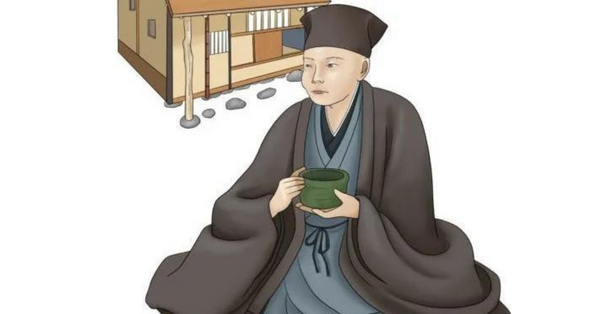
Rikyū became a friend and confidant of Toyotomi Hideyoshi, one of the most famous shoguns. The lover of tea ceremony, Hideyoshi used the most luxurious and expensive utensils. Rikyū, his tea master, put lots of effort to change the ceremony traditions. They should be closer to the principles of wabi-sabi. Due to Rikyū, the room, where the ceremony took place, became small. The kettle and tea utensils became very simple and cheap. The participants of the ceremony were sitting so close to one another. They could feel their breathing.
So, Rikyū re-designed the tea ceremony according to wabi-sabi ideas. They called the ceremony “Wabi-cha”, where “cha” is the shortened variant of “matcha”.
XVII Century: Wabi-sabi ideas penetrate the poetry
Matsuo Bashō wrote the next chapter in wabi-sabi history. Japanese called him “the father of haiku”. Japanese people value Matsuo till now as one of their most famous poets.
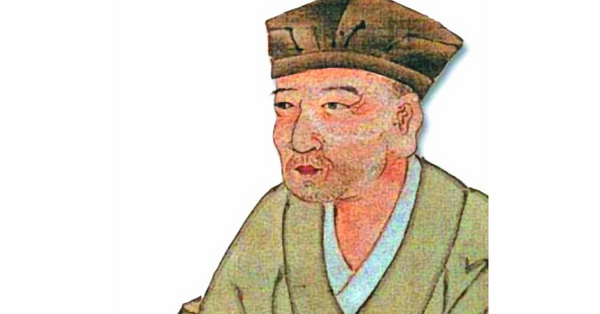
He understood the wabi-sabi ideas with his whole heart, traveling around the town of Edo. His road was dangerous. Matsuo pretended to be a beggar. He noticed the asymmetric beauty of nature around him. He understood wabi-sabi principles and put them into his haikus.
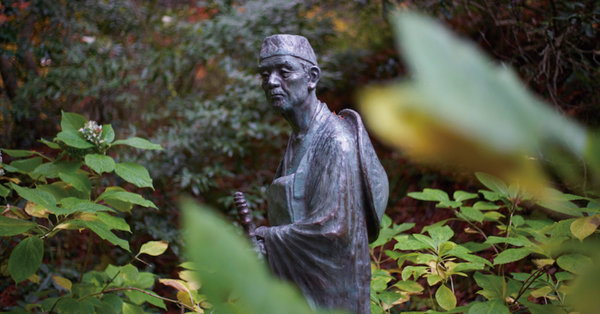
Thus, wabi-sabi started as philosophy and penetrated tea ceremonies and poetry. Later they used its ideas for creating home décor elements, including my favorite rugs.
But what wabi-sabi elements are in the interior design?
Wabi-Sabi Examples
Wabi-sabi, based on the Zen Buddhism philosophy, tells that words are not necessary. So, to understand the wabi-sabi ideas it is better to close your eyes and your ears. Try to feel the imperfectness of the moment with your whole heart.
But now I am going to speak about putting wabi-sabi ideas into practice. I’ve described the theory of wabi-sabi. But what are wabi-sabi examples around us?
The First Example of Wabi-Sabi
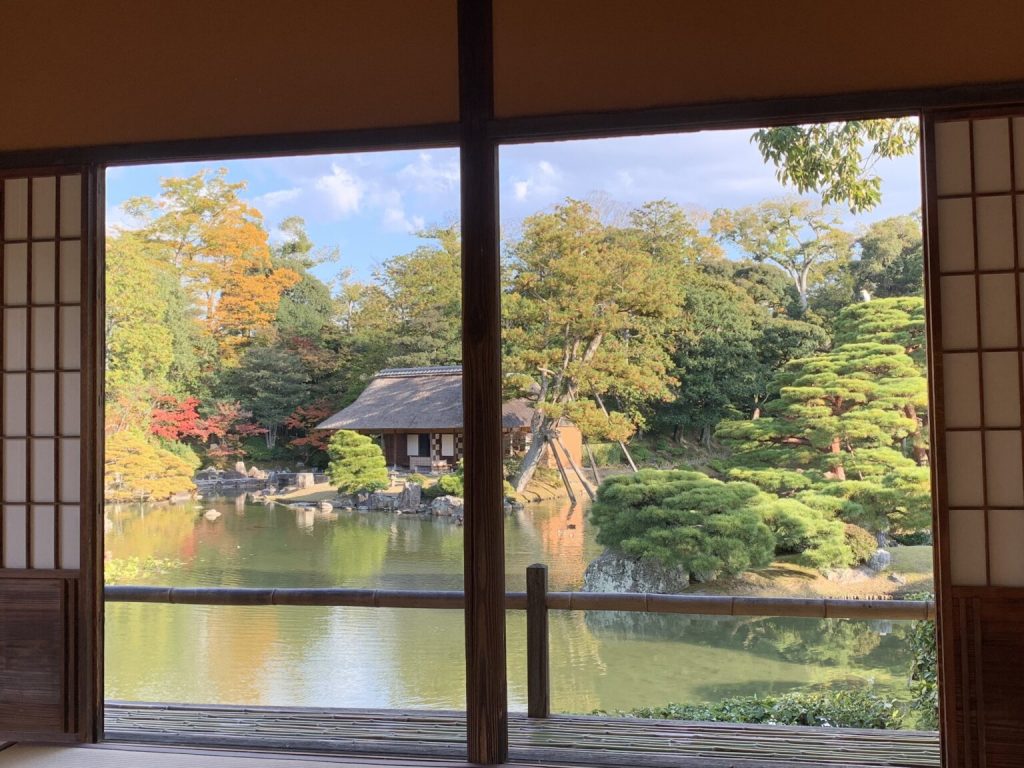
The first historical example of using wabi-sabi ideas in real life took place in the 16th century. According to the legend, Rikyū asked the student to clean the territory around the tea house. The boy spent long hours, cleaning each centimeter of the garden near the house. Then Rikyū inspected the student’s job and noticed that the look was ideal. After that, he shook the maple tree and a bunch of leaves fell on the path in front of the house. If you understand the beauty of this look, then you have already understood the idea of wabi-sabi.
Modern Examples of Wabi-Sabi
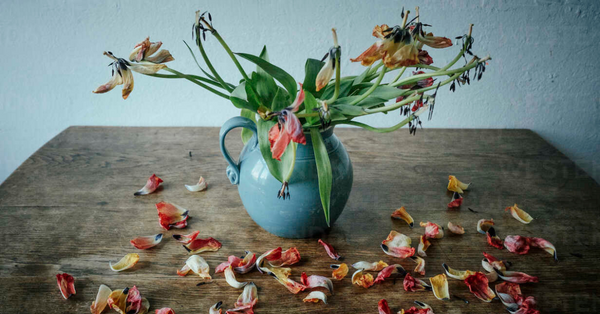
Even if you hear about wabi sabi for the first time, I am sure you have already seen lots of its examples around you. Here’s a short list of the situations, which reflect the ideas of wabi-sabi:
- On the windowsill, the petals, which fell from the flowers in the vase
- The crack on your favorite cup of tea
- The fingerprints on the washed mirror
- The patina on an old metal plate
- The asymmetrical shape of the ceramic bowl
Of course, very often you practice wabi-sabi without knowing it. Thus, you may keep at home the ceramic cup, which your kid made for you. Thus, it may look too rough and asymmetric, but you like it as this thing has a special meaning for you. Otherwise, you may have a sauce with the chipped piece, which your grandmother used when you were a kid. This sauce isn’t perfect, but you like it and enjoy its quite old charm.
You may see wabi-sabi examples not in the things around you, but also in food.
Wabi-Sabi Examples in Food
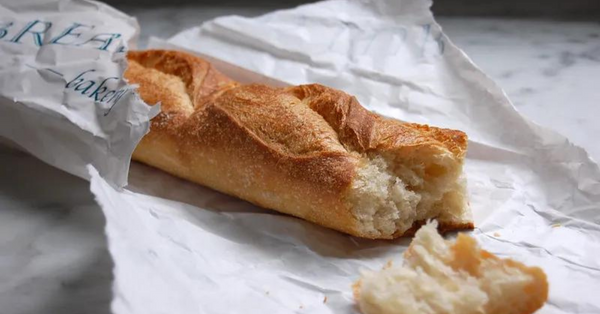
Like a devoted homemaker, I love ideally sliced lemon. I also admire perfectly cut bread or meat. But sometimes I am overfilled with the wabi-sabi mood. So, I tear the huge piece of bread from the loaf and cut the orange into not neat sharp juicy pieces. There’s some great sense and beauty in those imperfect products.
Wabi-Sabi Examples in Nature
Of course, there are plenty of wabi-sabi examples in the nature around us. The apples, which fell from the tree to the ground, were even tastier. The bouquet of small wildflowers has different colors and various numbers of petals. But they look even more beautiful, than lavish buds of roses or orchids.
The irregular shape of fruits and vegetables is the embodiment of wabi-sabi ideas.
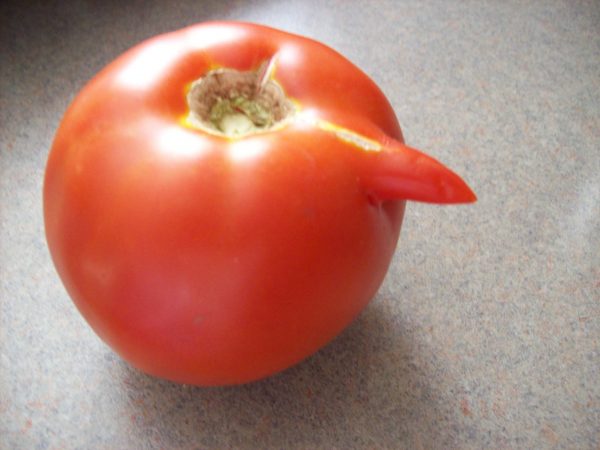
I felt better after I let the perfection go. I accepted the world around me with all its beautiful deficiencies.
I became a fan of the wabi-sabi world. Of course, one day I decided to join my 2 hobbies – wabi-sabi and home décor – and see, how it works.
Tips for Wabi-Sabi Home Décor
I know, that “having a moment” and valuing “what is passing by” is a kind of fashion today. I always tell my readers not to redesign their house, according to wabi-sabi ideas, if it is a trend for them. Wabi-sabi is a way of thinking and a lifestyle.
I started to make the wabi-sabi home long ago. Then I was lack of money but still wanted to create a great atmosphere for my husband and me. I found old cups at flea markets. I decorated the table with my grandmother’s tablecloth and put the huge bunch of mint in the shabby vase. Till now the fresh smell of mint occurs in my mind when I speak about the wabi-sabi charm.
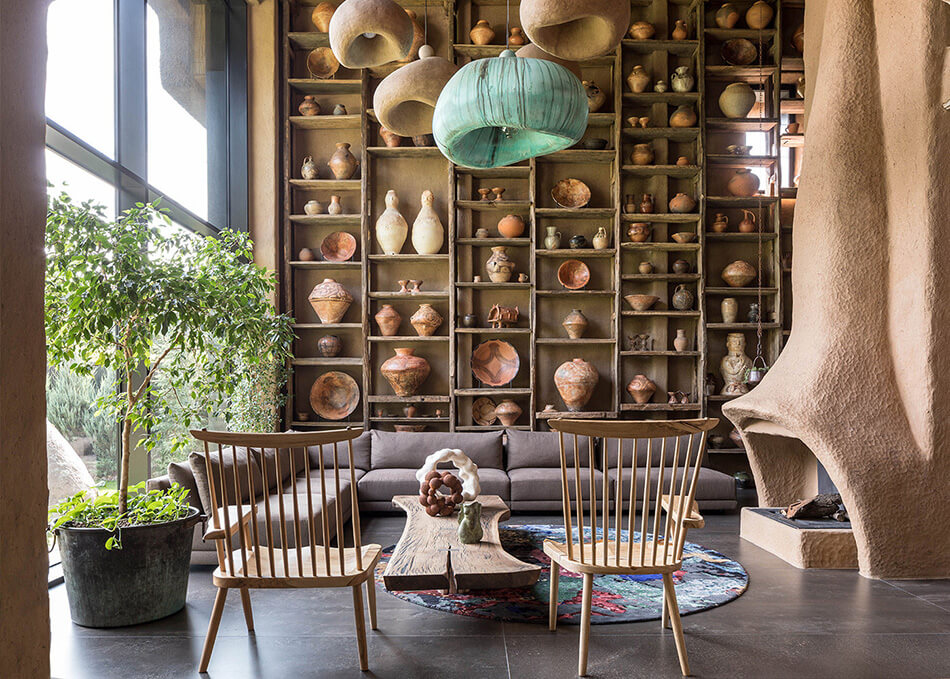
In general, I tell my readers not to be afraid of experiments. Wabi-sabi is the feeling, the mood, the emotion. So I can’t tell you, that this carpet, for example, is wabi-sabi and that one is not. It’s your decision and your personal choice of simple imperfect beauty. But to inspire you, I’ll give you tips for a wabi-sabi home.
7 Tips to Make Your Home Wabi-Sabi
Tip 1: Remove unnecessary items from your home space
Have you noticed, that unnecessary things always appear in your wardrobes and cupboards? Wabi-sabi is about love and consciousness. So, look at each thing in your house and ask yourself, “What sense does it have? What function does it fulfill? What mood does it create?” If you feel, that some item has nothing in common with the wabi-sabi atmosphere in your house, then get rid of it.
Keep in mind I don’t tell you to throw away the things, which can serve for many years. You can give the item, which you don’t need, to your friend or relative. Otherwise, you may donate it. Try not to keep more than 2 items of the same function in your house. For example, you don’t need more than 2 fur hats, little black dresses or classical trousers for the same season.
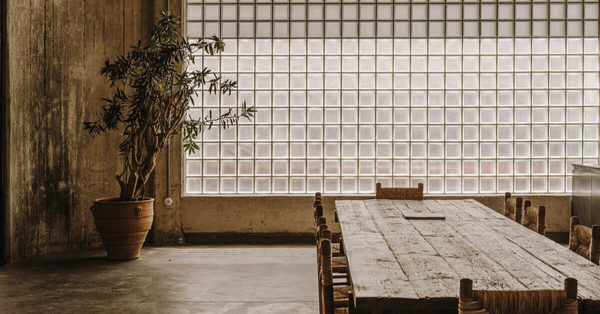
Declutter your space! Remove the unnecessary things! That is a very important tip for creating a wabi-sabi home.
Tip 2: Use the soft color palette for your house
Wabi-sabi style should bring more positivity into your life. It will also create a better mood every single day. The color palette plays a key role in creating positivity. As a rule, the wabi-sabi color palette is earthy, natural, and muffled. The wabi-sabi colors are natural, e.g. green, grey, and blue. I like these colors. So I buy rugs, curtains, and tablecloths in this palette. There’s a wabi-sabi vibe I am looking for in them.
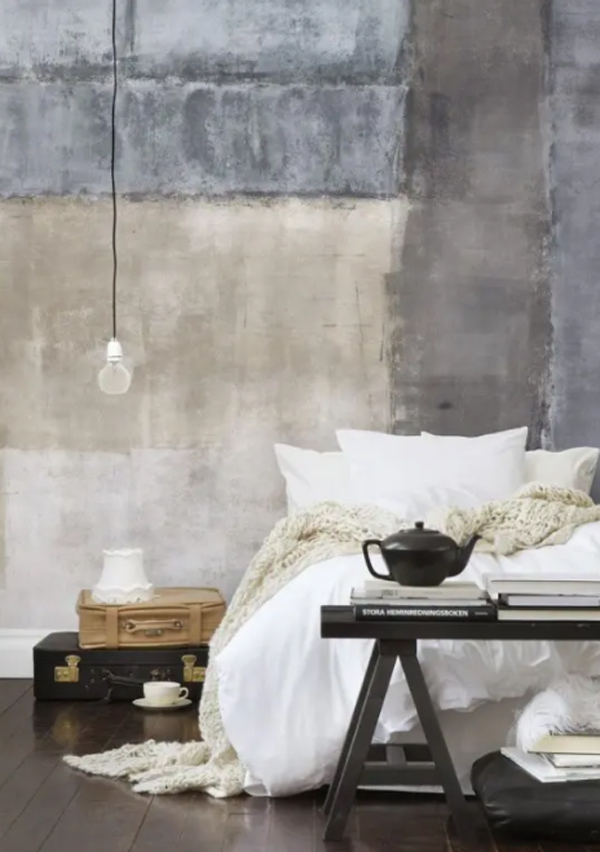
But there’s no strict rule about the color palette in the wabi-sabi style. I tell you to sit in a cozy armchair and see the answer with your inner sight. In what color you can see your natural, super cozy imperfect home? If you feel the calm natural beauty of pink, coral, or yellow color, choose it! And create a great wabi-sabi look at home.
Tip 3: Find interesting weathered furniture pieces for your room
Many people mix wabi-sabi style furniture with vintage. These 2 styles have a lot in common. Very often you can find great wabi-sabi things at the flea markets. The old metal cupboard with patina, worn rugs, which keep the memory of lives of those great people, who owned it, old drawings – all these things work great in wabi-sabi style.

There are online stores, where you can get wabi-sabi furniture. If you have no time and some extra money, you can get the necessary wabi-sabi styled furniture and accessories. Then you may create the space in wabi-sabi style. But I prefer to get such items myself.
Here are the main qualities the furniture piece should have to be wabi-sabi:
- The items with asymmetric lines
- The things, which have traces of the graceful aging
- The things, which play an important part in your family history
- Pieces of furniture, which look close to nature
- Soulful items
- Things with imperfections create a meaningful atmosphere
- Rustic things
Tip 4: Choose organic textures

The things you choose for the wabi-sabi room should have special organic textures. The texture is an important element of the wabi-sabi style. To create such space, choose natural materials for furniture, textile, floors, and carpets. Get such materials as wood, concrete, wool, and silk. As for home textile, choose knitted, rough things.
Tip 5: Create nature elements inside
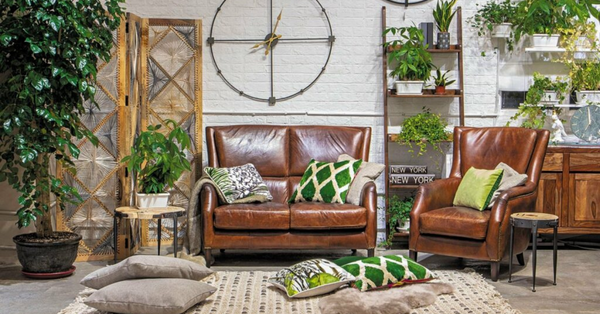
Wabi-sabi is close to nature. That’s why there should be lots of natural elements in your house. Put wildflowers in the cracked vase and put them on the windowsill. Get big plants with huge green lives in the old pots and put them on the floor near the sofa. You can also get several tree branches from your garden. Then you should dry them, and put them into a hand-plaited bamboo vase.
Tip 6: Don’t be afraid to choose the items, which are not matchy
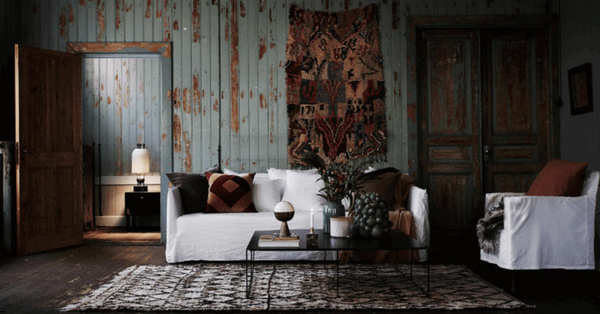
As I’ve mentioned above, one of the main wabi-sabi trends is asymmetry. So, it’s not necessary to get the items of furniture and accessories, which are cohesive. The great concept of wabi-sabi is creating the looks, which you like, without the burden to live in a perfect home. The wabi-sabi home is that one, which you love, and where you can relax.
Tip 7: Use a minimum of belongings to create a wabi-sabi atmosphere in your house
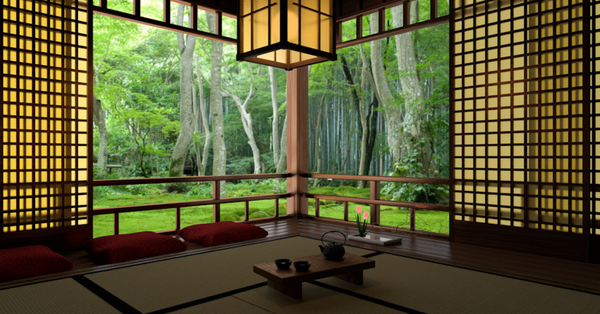
One of the basic wabi-sabi principles is minimalism. Each thing you have in the wabi-sabi home should be meaningful. I told you above about the necessity to get rid of the things you don’t use. So, it’s good for wabi-sabi style to have a minimum of possessions. But each item in your home should be that one, you love.
10 Trendy Rugs & Carpets for Wabi-Sabi Style
So, now you know, how to implement the wabi-sabi ideas into practice and create that gracefully imperfect atmosphere in your house. But we are moving forward, and now I am so eager to speak on the topic I like most of all – carpets and rugs.
As you know, I consider rugs as the items, which serve as the base of room décor. It connects all the separate elements of home décor into one common look. Of course, the rug, which lies on the floor in your wabi-sabi room should express its concept.
3 Principles for Wabi-Sabi Rugs
Here are 3 main criteria, which each wabi-sabi trendy carpet or rug should have.
1. The wabi-sabi rug should have the signs of graceful aging
2. The wabi-sabi rug should be in an earthy soft color palette
3. The wabi-sabi rug should be made of natural material
To be more persuasive, I offer you 10 rugs and carpets in wabi-sabi style.
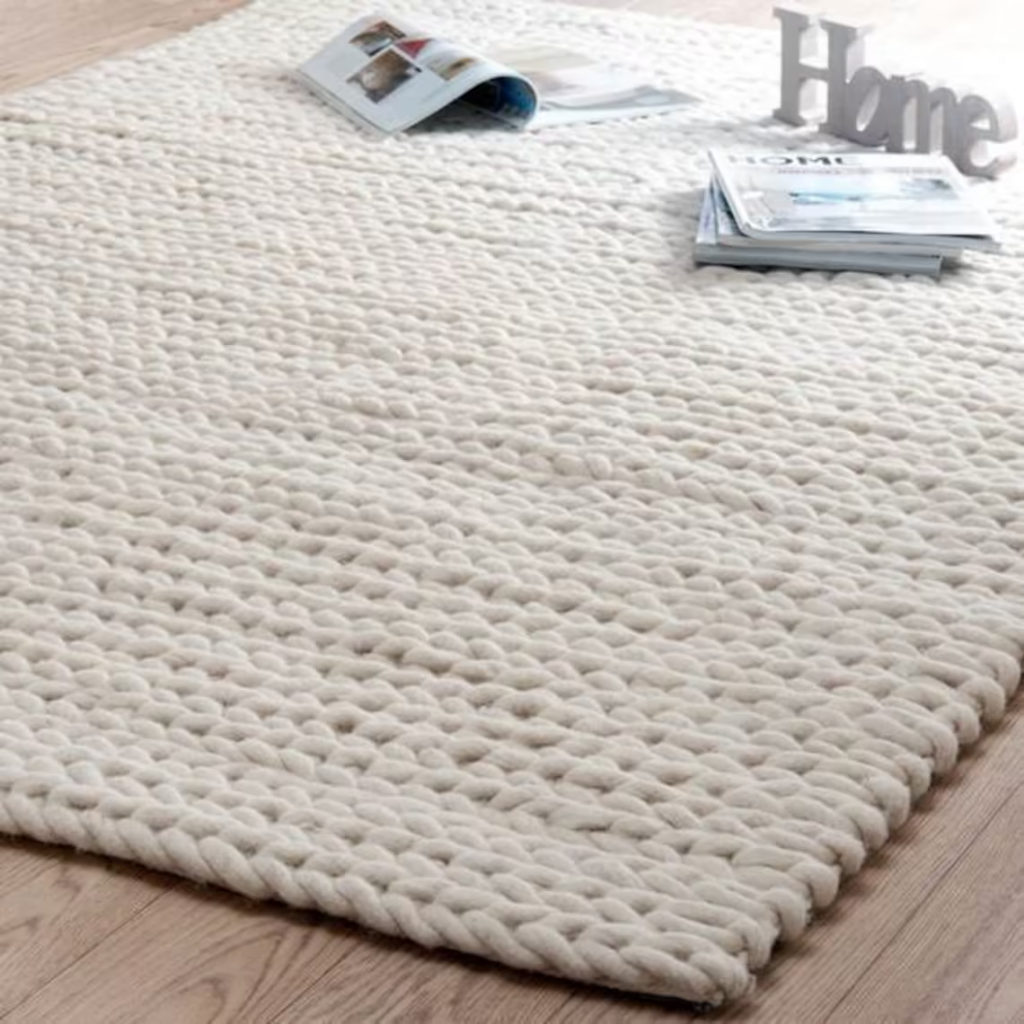
It is a perfectly imperfect rug in wabi-sabi style. The hand-made knitted rug looks very simple. It’s quite rough, very authentic, and reminds of those old-fashioned carpets, which our grannies used to make themselves for their homes. Such knitted carpets are not perfect, which makes them very close to wabi-sabi’s main idea. The material of this rug is natural – it’s woolen. The soft white color fits the cozy and calm wabi-sabi room.
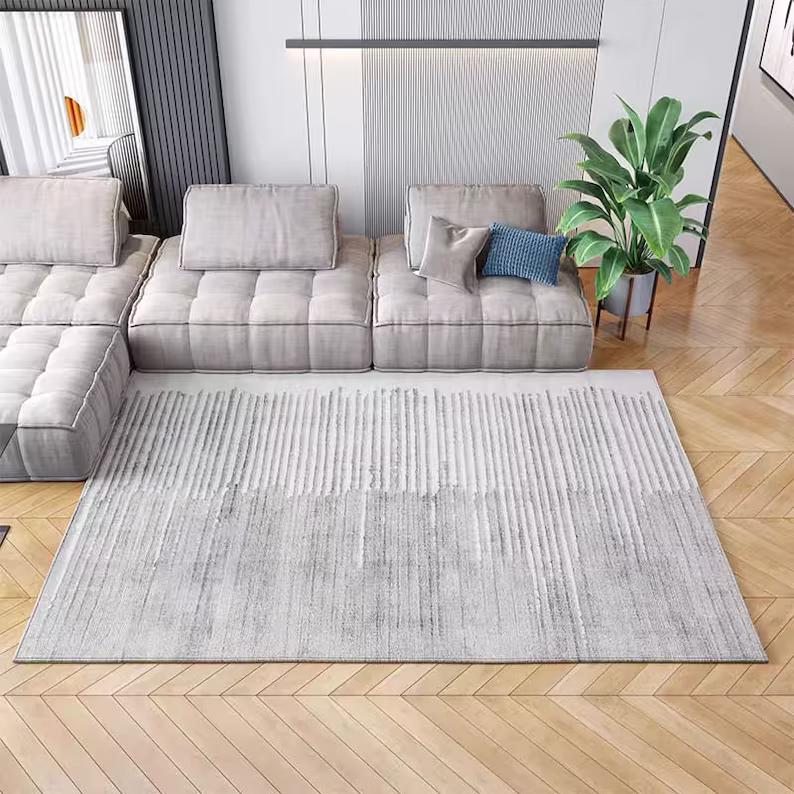
As the manufacturer tells, the design of the rug is in the Japanese wabi-sabi style. I don’t agree, that the rug has a classical wabi-sabi look. But it’s made of natural material – cotton. It has soft color. And it is quite simple. The small wabi-sabi rug is not perfect. But grayish stripes on its surface add some shabby charm.
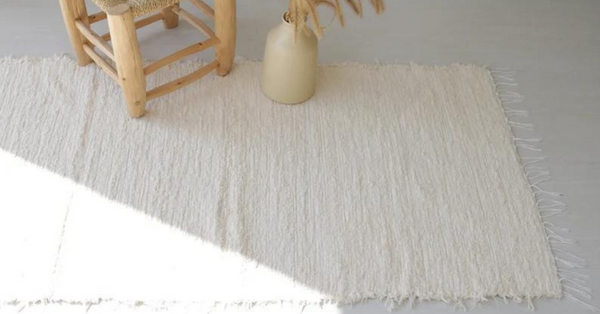
It is a simple creamy rug, which has a rough surface, some dents, and a ragged edge. Its imperfectly graceful style works great with wabi-sabi conception. The natural material – cotton – also suits the wabi-sabi idea. Just put this little imperfect covering on the floor in your bathroom or bedroom, add some old-fashioned wooden cupboard – and voila! You have a great premise with wabi-sabi vibes.
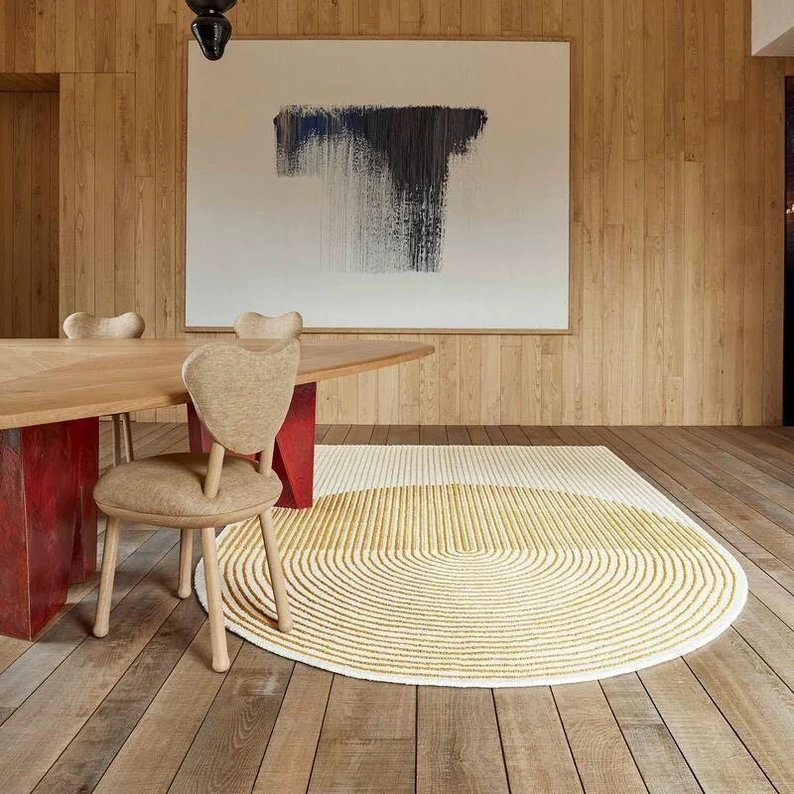
I like this rug for its unusual shape. It is round from one side and square from the other side. The round part is beige, while the square one is white. The rug is quite small, but it’s an ideal choice for the bedroom, small living room, or home office.
Its simple lines and soft colors create a philosophic calm mood. This rug is not luxurious; it’s very soft and cozy. I think it’s a great choice for the room in wabi-sabi style.
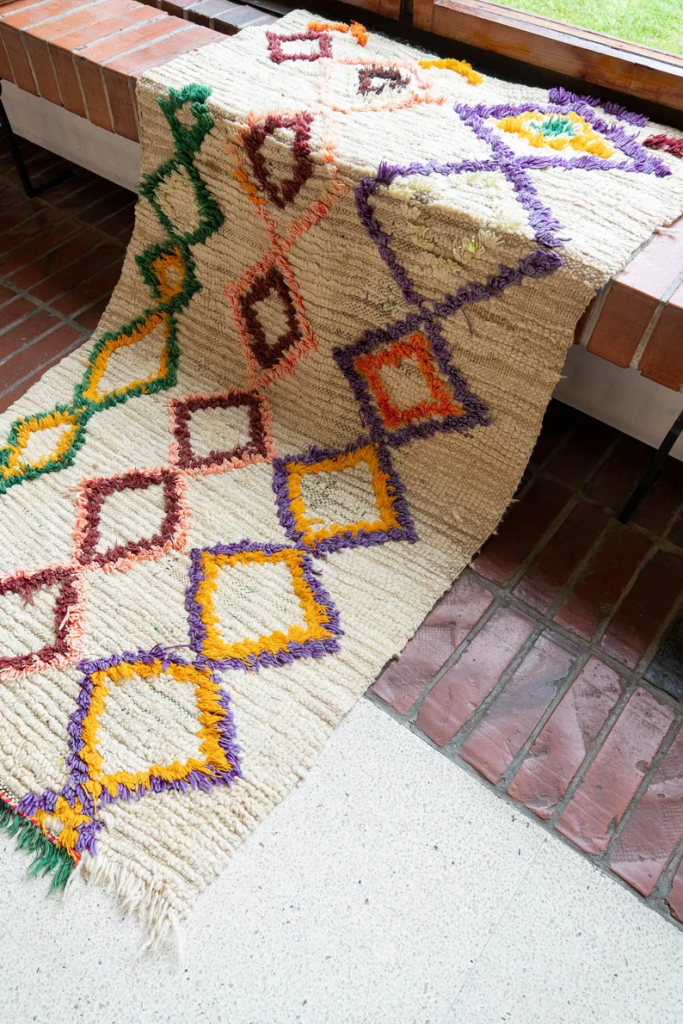
I have several reasons to recommend this carpet for the wabi-sabi room. First of all, it is made of natural material – wool. Then, it is a Berber carpet – with that rough steady surface, which reflects the wabi-sabi idea of natural simple beauty. Besides, this rug is vintage, so it reminds me of the time, which is passing.
The main color of this carpet is white. But it is decorated with several bright geometric patterns. This carpet is a good choice for those wabi-sabi lovers, who like some bright colors in their room.
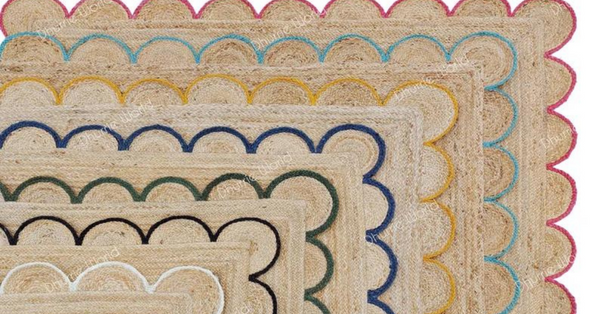
This fabulous rug seems to be created for the small room in wabi-sabi style. It is made of jute – simple natural material, quite rough and imperfect and very charming at the same time. The natural beige color of the rug is calm and simple. The rug may have the edging of a different color – red, blue, green, etc. You may choose that color of edging, which suits the general palette in your room.
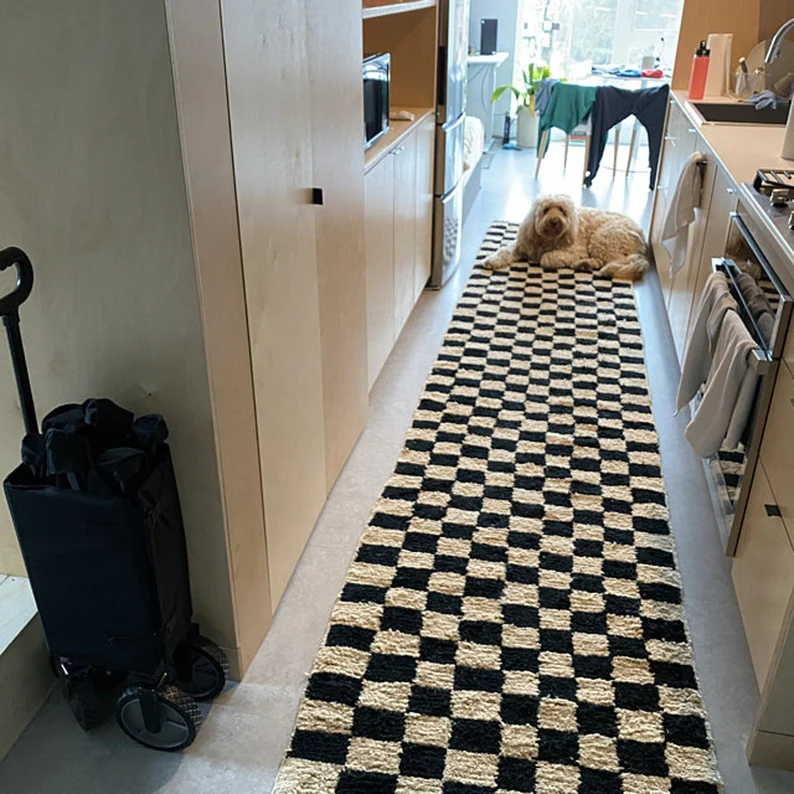
If you are looking for a wabi-sabi rug of rectangular shape, then the runner may be a great option for you. I like this Berber plaid rug and recommend it for the corridor or entryway in a wabi-sabi home. The soft woolen rug has a simple pattern – black and white plaid, which reminds a chessboard. This runner meets all the requirements of the wabi-sabi style. It looks simple, soulful, and cozy. Besides, it is easy to maintain. So, it won’t become a burden for you.
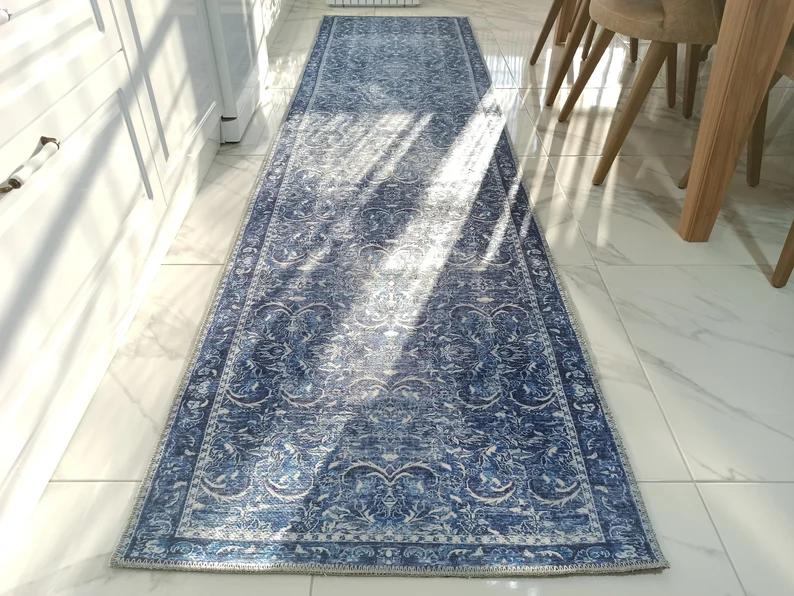
With wabi-sabi vision, you can admire the beauty of what is passing by. That’s why vintage rugs, made of natural materials, with shabby patterns and dim colors perfectly fit the home in wabi-sabi style.
This elegant dark blue vintage rug is handmade. Looking at it, you can imagine it lying on the floor in some rich Turkish house in the past. Obviously, it was luxurious in the past, but now it looks much older and simpler, like a middle-aged Turkish sultan, which lost his power.
The rug is made of cotton and polyester. It feels very comfortable if you step at it barefoot. So, consider this option, if you plan to create the house in the wabi-sabi concept.
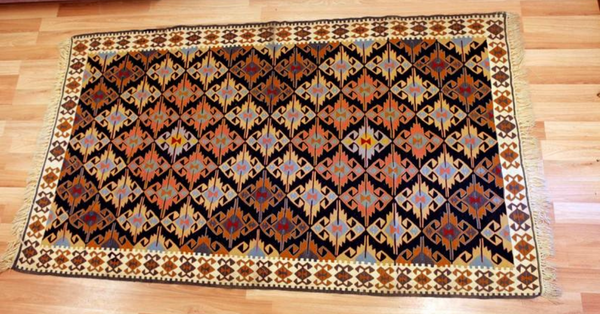
Wabi-sabi is a mood, that’s why you shouldn’t refuse rugs with brighter patterns if you like them. This vintage rug with geometric patterns seems too bright for a wabi-sabi home. But it’s shabby surface, long history, which stands behind it, and elegant imperfections, make this rug fit wabi-sabi ideas.
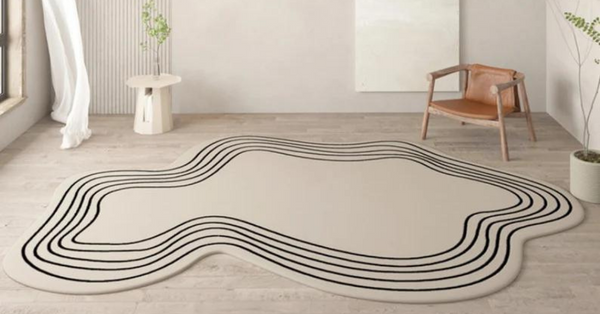
Do you remember that one of the most important principles of wabi-sabi is asymmetry? That’s why the last but not the least rug on my list has an irregular shape. It is not vintage, but I feel wabi-sabi vibes from it. It creates an easy-going mood. Its colors – light beige and black – are calm and natural, so they are suitable for the house in the wabi-sabi style.
The rug’s material – polyester – is not natural. Still, I think, it’s a great choice for a wabi-sabi home.
Conclusion
So, I hope you’ve read my post attentively. And now you love and understand the wabi-sabi lifestyle and philosophy with your whole heart, just as I do. A big home décor fan, I offered you several tips to create a home in wabi-sabi style. Besides, I offered you 10 trendy rugs, which can serve as a base for wabi-sabi home décor. I want to remind you that wabi-sabi is an emotion you feel when you see some home items, landscapes, or carpets. So, just open your heart to wabi-sabi ideas and create an imperfect space, which you’ll like!
